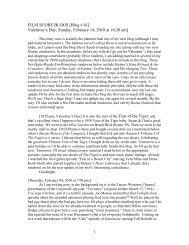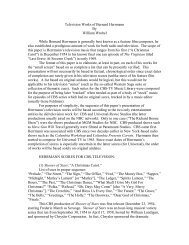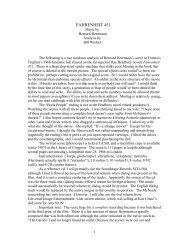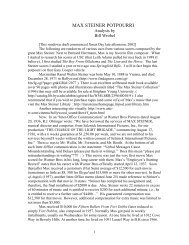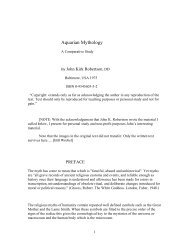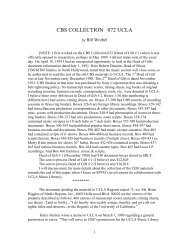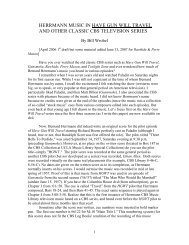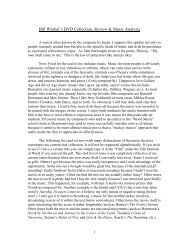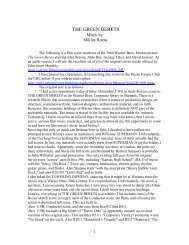The Deleted Music & Scenes from Journey to the Center of the Earth
The Deleted Music & Scenes from Journey to the Center of the Earth
The Deleted Music & Scenes from Journey to the Center of the Earth
You also want an ePaper? Increase the reach of your titles
YUMPU automatically turns print PDFs into web optimized ePapers that Google loves.
JOURNAL OF POPULAR MUSIC HISTORY<br />
SNEAK PEEK: “<strong>The</strong> <strong>Deleted</strong> <strong>Music</strong> & <strong>Scenes</strong> <strong>from</strong> <strong>Journey</strong> <strong>to</strong> <strong>the</strong><br />
<strong>Center</strong> <strong>of</strong> <strong>the</strong> <strong>Earth</strong>”<br />
by<br />
Bill Wrobel<br />
http://www.equinoxjournals.com/PMH/issue/current<br />
Note: <strong>The</strong> Journal <strong>of</strong> Popular <strong>Music</strong> His<strong>to</strong>ry [http://www.equinoxpub.com/PMH ]<br />
by Equinox Publishing Ltd based in <strong>the</strong> UK is now <strong>of</strong>fering a special Bernard Herrmann<br />
issue celebrating his 100 th anniversary <strong>of</strong> birth. Actually, by <strong>the</strong> time you read this, it will<br />
already be a fact since I am writing this about a month before <strong>the</strong> unveiling. As <strong>of</strong> this<br />
writing [initiated Tuesday, May 17, 2011] I anticipate it will be released online by mid-<br />
June 2011 at <strong>the</strong> latest. [Note: Writing this note on June 30, it actually <strong>to</strong>ok about two<br />
weeks later but still on time for <strong>the</strong> 100 th day yesterday] A hardcopy edition will also be<br />
available. Last week I submitted my final pro<strong>of</strong> read and corrections <strong>of</strong> my two articles <strong>to</strong><br />
<strong>the</strong> edi<strong>to</strong>rial service. <strong>The</strong> deadline for <strong>the</strong>se corrections and changes was May 16 because<br />
<strong>the</strong> Journal is overdue an issue by over a year. That’s okay because <strong>the</strong> special Herrmann<br />
issue will be worth <strong>the</strong> wait!<br />
Ed Green <strong>of</strong> <strong>the</strong> Manhattan School <strong>of</strong> <strong>Music</strong>—a fine fellow indeed-- is <strong>the</strong> guest<br />
edi<strong>to</strong>r for this issue. It was his brainchild project way back in mid-2009 <strong>to</strong> provide a<br />
Herrmann Centenary book and journal <strong>of</strong> scholarly essays. In fact, his project was <strong>the</strong><br />
“only game in <strong>to</strong>wn,” so <strong>to</strong> speak, because nobody else (that we are presently aware <strong>of</strong>) is<br />
successfully going forth with a similar project in <strong>the</strong> academic field. <strong>The</strong> University <strong>of</strong><br />
Mississippi Press was <strong>the</strong> first publisher option but for some reason it didn’t work out.<br />
<strong>The</strong> idea was <strong>to</strong> have eight authors contribute papers on some aspect <strong>of</strong> Herrmann’s<br />
music. One writer was <strong>to</strong> focus on Citizen Kane, ano<strong>the</strong>r on third-relations harmony,<br />
ano<strong>the</strong>r on Herrmann’s radio work, ano<strong>the</strong>r on Herrmann’s television music, one on<br />
Marnie, one on Herrmann’s relationship with Ives, and so forth.<br />
When I was originally asked in June 2009, I initially came up with <strong>the</strong> idea <strong>to</strong> focus<br />
on <strong>the</strong> Box 109 sketches at UCSB, “fleshing” <strong>the</strong>m out in<strong>to</strong> fully orchestrated pieces.<br />
However, this was not appealing <strong>to</strong> <strong>the</strong> edi<strong>to</strong>rs/publishers because <strong>of</strong> copyright<br />
complications, etc. So I thanked <strong>the</strong>m for considering me, and I left <strong>the</strong> probable project.<br />
Besides, I was busy with <strong>the</strong> big CBS paper for my own website, and my order at UCSB<br />
<strong>to</strong> get <strong>the</strong> complete scans <strong>of</strong> <strong>the</strong> Box 109 sketches were late in coming [<strong>the</strong>y still haven’t<br />
arrived as <strong>of</strong> late June!]. Never<strong>the</strong>less, I was pitched again in June 2010 <strong>to</strong> participate,<br />
this time <strong>to</strong> be published in <strong>the</strong> Equinox Journal <strong>of</strong> Popular Film His<strong>to</strong>ry, and <strong>the</strong>n a year<br />
or less later in 2012 in book form (probably enlarged). <strong>The</strong> deadline was for all eight or<br />
1
nine authors <strong>to</strong> submit <strong>the</strong>ir works by around <strong>the</strong> start <strong>of</strong> 2011 for initial edits and o<strong>the</strong>r<br />
process changes. However, I was informed <strong>to</strong>wards <strong>the</strong> end <strong>of</strong> February 2011 that <strong>the</strong><br />
book project was “out” simply because most <strong>of</strong> <strong>the</strong> scholars who promised <strong>the</strong>ir essays<br />
never followed thru. Once David Laing, <strong>the</strong> edi<strong>to</strong>r <strong>of</strong> <strong>the</strong> Journal <strong>of</strong> Popular <strong>Music</strong><br />
His<strong>to</strong>ry, realized that three authors had already completed <strong>the</strong>ir papers (four papers if you<br />
include my two contributions) it meant that <strong>the</strong> Journal special issue was still viable. If<br />
you include <strong>the</strong> newest paper and also a Journal Intro by Ed Green, Equinox would have<br />
more than enough material for a PMH journal issue—and in time for <strong>the</strong> 100 th<br />
anniversary!<br />
Now: Officially now <strong>the</strong> papers will definitely include one by Jonathan Waxman<br />
on Herrmann’s relation with Charles Ives; one by Tom Schneller on Marnie; one by Ed<br />
Green on Herrmann’s involvement (and not) with pop/popular music; and two by yours<br />
truly. <strong>The</strong> larger <strong>of</strong> my two papers is titled “<strong>The</strong> <strong>Deleted</strong> <strong>Music</strong> & <strong>Scenes</strong> <strong>from</strong> <strong>Journey</strong><br />
<strong>to</strong> <strong>the</strong> <strong>Center</strong> <strong>of</strong> <strong>the</strong> <strong>Earth</strong>” (Article 003, about 21 Journal format pages). <strong>The</strong> o<strong>the</strong>r paper<br />
(article 005) tagged at <strong>the</strong> end <strong>of</strong> <strong>the</strong> Journal issue is “Resources and Herrmann<br />
Research” (about 7 pages). I conceived <strong>of</strong> <strong>the</strong> JTTCOTE idea at <strong>the</strong> end <strong>of</strong> June 2010<br />
after Ed asked if I could come up with anything involving Herrmann’s fantasy films. I<br />
worked on it steadily on my <strong>of</strong>f-work days (and <strong>of</strong> course evenings)—no vacation during<br />
that period-- and I was pretty much finished with <strong>the</strong> near-polished draft by mid-<br />
September 2010, and actually sent it <strong>of</strong>f <strong>to</strong> Ed in a more polished or edited format on <strong>the</strong><br />
power date <strong>of</strong> 10-10-10 (Oc<strong>to</strong>ber 10, 2010). <strong>The</strong>n I did not hear <strong>from</strong> anybody until 2-22-<br />
11 when <strong>the</strong> authors who actually contributed were notified that <strong>the</strong> book project was<br />
out—but that <strong>the</strong> Journal version was still “in” if everybody agreed (everybody did). I<br />
was surprised many <strong>of</strong> those scholars originally tapped for <strong>the</strong> book did not deliver <strong>the</strong><br />
goods. Some <strong>of</strong> those names were instantly recognizable <strong>to</strong> me. I suppose o<strong>the</strong>r<br />
commitments—and Fa<strong>the</strong>r Time—made delivery unlikely. Perhaps some had second<br />
doubts. That’s unfortunate. I would’ve enjoying reading a book (collection <strong>of</strong> papers by<br />
eight or nine authors) <strong>of</strong> great merit on Herrmann. But this special PMH journal issue<br />
should be quite excellent indeed, and I expect a good seller for Equinox since <strong>the</strong>re is a<br />
strong fan base out <strong>the</strong>re, scholarly or not, who love Herrmann’s music.<br />
My JTTCOTE paper was fun <strong>to</strong> write, although I was disappointed I could not<br />
gain access in<strong>to</strong> Fox <strong>to</strong> research <strong>the</strong>ir archival library materials on <strong>the</strong> movie. I wrote<br />
about this in my paper but <strong>the</strong> section quoted immediately below was largely deleted by<br />
<strong>the</strong> edi<strong>to</strong>rs (basically non-essential lines removed <strong>to</strong> manage size restraints in <strong>the</strong><br />
Journal):<br />
“As a side comment here, it would be quite revealing <strong>to</strong> study <strong>the</strong> original<br />
or first (un-revised) screenplay <strong>of</strong> <strong>the</strong> movie, and all subsequent revised movie<br />
scripts before <strong>the</strong> final edits <strong>to</strong>ok place. Unfortunately, while I tried <strong>to</strong> research<br />
<strong>the</strong> JTTCOTE archive materials at Fox <strong>Music</strong>, <strong>the</strong> company’s policy is generally<br />
not <strong>to</strong> let outsiders in. In fact, <strong>the</strong>y even let insiders out. For example, I know<br />
somebody who is a long-term employee <strong>of</strong> Fox who tried <strong>to</strong> research materials<br />
for me (recording session logs, music budget sheets, screenplays, etc.), but she<br />
was informed that research requests for personal use are denied, even <strong>to</strong><br />
2
employees, because company policy is <strong>to</strong> only provide research for <strong>of</strong>ficial Fox<br />
productions. So while I tried <strong>to</strong> unearth buried production information <strong>from</strong> Fox<br />
<strong>Music</strong> regarding JTTCOTE, I was unable <strong>to</strong> enter those subterranean realms….”<br />
Never<strong>the</strong>less I managed <strong>to</strong> acquire enough interesting material <strong>to</strong> write a<br />
substantial-enough paper. <strong>The</strong> first primary source <strong>of</strong> information was <strong>the</strong> <strong>of</strong>ficial trailer<br />
<strong>of</strong> <strong>the</strong> movie itself included in <strong>the</strong> dvd release <strong>of</strong> JTTCOTE. You can also access <strong>the</strong><br />
trailer lasting 3:18 on YouTube. About six and a half minutes <strong>of</strong> music Herrmann<br />
originally composed for <strong>the</strong> movie was not used (deleted). Some was scribbled out by<br />
Herrmann himself but most <strong>of</strong> <strong>the</strong> excising was done by edi<strong>to</strong>rs. For example, in <strong>the</strong><br />
<strong>the</strong>atrical trailer, as James Mason (in voice-over) gives a colorful <strong>to</strong>ur-guide monolog<br />
about <strong>the</strong> movie, you will see a fragment <strong>of</strong> a deleted scene (01:20 - 01:22) <strong>of</strong> <strong>the</strong><br />
Pr<strong>of</strong>essor himself descending first in<strong>to</strong> <strong>the</strong> Scartaris-designated chimney within <strong>the</strong> crater<br />
<strong>of</strong> Mount Snaeffels-Jokull. This corresponds <strong>to</strong> “<strong>The</strong> Rope I” cue Herrmann composed,<br />
but this 24-second scene was ultimately cut out by <strong>the</strong> edi<strong>to</strong>rs. You will need <strong>to</strong> purchase<br />
my paper <strong>from</strong> Equinox in order <strong>to</strong> read my many o<strong>the</strong>r examples.<br />
Note: Normally I give out my information completely free <strong>of</strong> charge on my<br />
filmscorerundowns.net site. However, this was one exceptionally rare time I agreed <strong>to</strong><br />
write articles for an entity and sign over my rights. <strong>The</strong> only o<strong>the</strong>r time was in 1985 when<br />
Dr. Zipporah Dobyns and I collaborated on Seven Paths To Understanding (now out-<strong>of</strong>print).<br />
Even here <strong>the</strong> copyright reverted back <strong>to</strong> me. I cannot put my Equinox material<br />
online (electronically) except perhaps as rewrites in order here <strong>to</strong> advertise (inform o<strong>the</strong>rs<br />
with teaser information) <strong>of</strong> <strong>the</strong> merits <strong>of</strong> this special Journal issue (and suggest that you<br />
buy it <strong>from</strong> Equinox!). <strong>The</strong> issue is not out yet but I believe <strong>the</strong> fee for my paper will be<br />
12 GPB (or $19.41 in <strong>to</strong>day’s currency rate). [Note written June 30 th : Actually my<br />
JTTCOTE paper will cost 16.80 GBP or about $26.89] None <strong>of</strong> that money (no royalty)<br />
will come <strong>to</strong> me. I think <strong>the</strong> only benefit I will receive (besides <strong>the</strong> pr<strong>of</strong>essional<br />
presentation <strong>of</strong> my works thanks <strong>to</strong> Equinox) is being able <strong>to</strong> get a discount <strong>of</strong> 20% on<br />
journal papers and 35 % on books available by Equinox (I’d prefer free <strong>of</strong> course since<br />
that is my philosophical bent!). Of course, logically speaking, since I already <strong>of</strong>fer my<br />
works freely via my own site, I am <strong>of</strong>fering my hard labor and finished works <strong>to</strong> Equinox<br />
for free as well (just in a different format)—except that, in this case, I have assigned<br />
away my copyright. That, as mentioned earlier, I am not normally predisposed <strong>of</strong> doing!<br />
Even my Herrmann Self-Borrowing paper that <strong>to</strong>ok years <strong>to</strong> carefully research and write<br />
was freely given <strong>to</strong> <strong>the</strong> original Journal <strong>of</strong> Film <strong>Music</strong>—but I did not sign away my<br />
rights. Curiously, however, that Journal is now assigned <strong>to</strong> Equinox, and I discovered that<br />
my paper <strong>from</strong> <strong>the</strong> pre-Equinox publishing <strong>of</strong> that early issue is now available for sale<br />
(14.40 GPB or $23.29 <strong>to</strong>day) via Google Checkout:<br />
http://www.equinoxjournals.com/JFM/article/view/6803/7180<br />
You can freely read a fair portion <strong>of</strong> that paper here on my site:<br />
3
http://www.filmscorerundowns.net/herrmann/sneakpeek2.pdf<br />
At any rate, returning <strong>to</strong> JTTCOTE, ano<strong>the</strong>r primary source <strong>of</strong> information I<br />
obtained was <strong>the</strong> so-called “Final” screenplay <strong>of</strong> <strong>the</strong> film dated June 25, 1959 but<br />
annotated underneath, “Rev. 8-31-59.” No screenplay was available free online (I<br />
checked long and hard on Google) so I purchased it for less than ten bucks<br />
(downloadable version) and also a hardcopy version <strong>from</strong> ano<strong>the</strong>r vendor (I forgot what I<br />
paid for that one—maybe $15 or so). So, besides <strong>the</strong> <strong>the</strong>atrical trailer, <strong>the</strong> screenplay<br />
document <strong>of</strong>fers fur<strong>the</strong>r pro<strong>of</strong> <strong>of</strong> <strong>the</strong> ultimate changes (i.e., edits) in <strong>the</strong> finished feature<br />
film because it shows many scenes and dialog lines not kept in <strong>the</strong> movie. Note that it is<br />
an intermediary script; that is, not <strong>the</strong> actual “final” script that corresponds scene-byscene<br />
and word-for-word <strong>to</strong> <strong>the</strong> finished product as presented in <strong>the</strong> <strong>of</strong>ficial release. For<br />
instance, <strong>the</strong> true final screenplay would include <strong>the</strong> flooding <strong>of</strong> <strong>the</strong> quartz grot<strong>to</strong> scene<br />
(not included in <strong>the</strong> 8-31-59 revised screenplay).<br />
After about five pages <strong>of</strong> preliminary overview material, I start <strong>the</strong> next and major<br />
section <strong>of</strong> <strong>the</strong> paper that focuses on each and every cue in <strong>the</strong> movie. Here’s a rewritten<br />
example:<br />
“<strong>The</strong> Mountain” (dvd 00:22:36 – 00:22:54). This cue <strong>of</strong> 13 bars was<br />
substantially changed in <strong>the</strong> final edit <strong>of</strong> <strong>the</strong> movie. Only <strong>the</strong> first four bars remain in <strong>the</strong><br />
movie followed by a fragment <strong>of</strong> Boone’s song, “My Heart’s in <strong>the</strong> Highlands,” a Public<br />
Domain work composed by J.M. Courtney. <strong>The</strong> screenplay reveals what <strong>the</strong> missing<br />
scenes and dialog lines were meant for those nine bars <strong>of</strong> music cut in <strong>the</strong> final edit. First<br />
Lindenbrook eagerly climbs up <strong>the</strong> slope <strong>of</strong> Snaeffels-Jokull with Alec far behind. Upon<br />
reaching <strong>the</strong> <strong>to</strong>p, he peers awestruck at <strong>the</strong> inside <strong>of</strong> <strong>the</strong> yawning crater, lifts his cap, and<br />
exclaims, “Greetings, Arne Saknussemm! I’m a little late, but I’m here.” It is interesting<br />
<strong>to</strong> note that in <strong>the</strong> initial establishing shot <strong>of</strong> <strong>the</strong> extinct volcano with neighboring peak,<br />
Scartaris, <strong>the</strong> screenplay indicated, “<strong>The</strong> background music plays a symphonic Icelandic<br />
<strong>the</strong>me.”<br />
“<strong>The</strong> Mountain Top” (dvd 00:45:46 – 00:46:18). This cue, which precedes <strong>the</strong><br />
famous “Sunrise” cue, was also radically reduced in <strong>the</strong> final edit <strong>of</strong> <strong>the</strong> movie,<br />
suggesting a hefty cut in <strong>the</strong> scene <strong>from</strong> what Herrmann originally scored for. This<br />
section <strong>of</strong> <strong>the</strong> movie always seemed a bit hurried <strong>to</strong> me, and it was substantiated upon<br />
noting <strong>the</strong> dramatic deletion <strong>of</strong> music (20 out <strong>of</strong> 27 bars). <strong>The</strong> screenplay reveals what<br />
scenes were edited out. For example, I always wondered why Lindenbrook was holding a<br />
gun at <strong>the</strong> rim <strong>of</strong> <strong>the</strong> crater. <strong>The</strong> reason is that it served as a deterrent against Count<br />
Saknussemm. In <strong>the</strong> screenplay, <strong>the</strong> Pr<strong>of</strong>essor had actually called out <strong>the</strong> Count twice<br />
while holding <strong>the</strong> rifle. Lindenbrook <strong>the</strong>n strongly voiced a long statement that he knew<br />
why <strong>the</strong> police could not find Saknussemm—not in his castle or in <strong>to</strong>wn--because he was<br />
here somewhere, hiding, waiting for <strong>the</strong> sunrise on this last day <strong>of</strong> May, and he appealed<br />
<strong>to</strong> him, as one scientist <strong>to</strong> ano<strong>the</strong>r, <strong>to</strong> come <strong>to</strong> his senses. Meanwhile Alec was looking in<br />
all directions for any sighting <strong>of</strong> <strong>the</strong> Count—or maybe his gun!<br />
4
“<strong>The</strong> Sleep” (dvd 00:58:37 – 00:59:12). Much <strong>of</strong> this cue was “put <strong>to</strong> sleep,” so<br />
<strong>to</strong> speak, in <strong>the</strong> final edit <strong>of</strong> <strong>the</strong> movie. During <strong>the</strong> first take <strong>of</strong> this cue during <strong>the</strong><br />
recording session, Herrmann hit his ba<strong>to</strong>n on <strong>the</strong> stand, and growled, “That isn’t good<br />
enough! C’mon, let’s try ano<strong>the</strong>r one. Keep it going. One more!” Buy <strong>the</strong> article if you<br />
want <strong>to</strong> know what else Herrmann said!<br />
“<strong>The</strong> Grot<strong>to</strong>” (starting 1:05:00 on <strong>the</strong> dvd). This cue <strong>of</strong> 22 bars displays<br />
scintillating music about “<strong>the</strong> fantastically beautiful quartz grot<strong>to</strong>” (James Mason’s words<br />
in <strong>the</strong> trailer) that was kept intact in <strong>the</strong> movie. However, <strong>the</strong> screenplay indicates a far<br />
longer stay at this “Cave <strong>of</strong> Rose Quartz.” I discuss <strong>the</strong>se interesting scenes in my <strong>of</strong>ficial<br />
paper. I sure wish I could’ve stayed longer in that pre-flooded quartz grot<strong>to</strong>!<br />
“<strong>The</strong> Canyon” (dvd 1:27:40 – 1:29:14). This is a superb cue with a quite<br />
interesting middle section <strong>of</strong> six bars (Bars 10 thru 15), which was unfortunately edited<br />
out, as well as end Bar 26. I would love <strong>to</strong> hear <strong>the</strong> missing 27 seconds res<strong>to</strong>red in a new<br />
recording because that dynamic middle section is a vibrant variation <strong>of</strong> <strong>the</strong> triplet-driven<br />
structure <strong>of</strong> this cue, utilizing an inter-play <strong>of</strong> different orchestral colors. <strong>The</strong>n I discuss a<br />
screenplay scene (probably filmed) that was edited out <strong>of</strong> <strong>the</strong> movie.<br />
“Time Passage” (dvd 1:30:29 – 1:30:42). This cue <strong>of</strong> 13 bars was meant <strong>to</strong> play<br />
39 seconds but, unfortunately, <strong>the</strong> film edi<strong>to</strong>r cut <strong>the</strong> original extended scene <strong>to</strong> I believe<br />
<strong>the</strong> first three bars and <strong>the</strong> final bar <strong>of</strong> arpeggiandos played by <strong>the</strong> harps. “Time Passage”<br />
suggests a relatively lengthy period <strong>of</strong> time shown as a montage <strong>of</strong> passing scenes. We<br />
see only two <strong>of</strong> <strong>the</strong>m, especially <strong>the</strong> experience with <strong>the</strong> “phenomenal winds.” <strong>The</strong><br />
screenplay indeed indicates an expanded montage, and I <strong>the</strong>n discuss <strong>the</strong>se in my paper.<br />
Anyway, I hope this sneak peek in<strong>to</strong> my JTTCOTE paper will interest you<br />
sufficiently enough <strong>to</strong> plumb in<strong>to</strong> your pocket or pocketbook <strong>to</strong> purchase it <strong>from</strong><br />
Equinox. Moreover I provided a wealth <strong>of</strong> online links that I am sure most people were<br />
not aware <strong>of</strong>—sights <strong>of</strong> unplumbed depths on <strong>the</strong> movie that will amaze and as<strong>to</strong>und<br />
you!…Hmmmm, I’m starting <strong>to</strong> sound like James Mason’s guide-<strong>to</strong>ur monolog on <strong>the</strong><br />
<strong>of</strong>ficial trailer!<br />
Once again, here is <strong>the</strong> updated url <strong>of</strong> <strong>the</strong> PMH journal that links directly <strong>to</strong> <strong>the</strong><br />
special Herrmann issue:<br />
http://www.equinoxjournals.com/PMH/issue/current<br />
[POSTSCRIPT-- Written Thursday, August 04, 2011 at 7:04 pm PDT]:<br />
In <strong>to</strong>day’s snail mail I finally received my hardcopy issue <strong>of</strong> this volume (Volume<br />
5.1 2010). I was expecting <strong>the</strong> print issue <strong>to</strong> be roughly 8 x 10.5 inches (such as previous<br />
issues <strong>of</strong> <strong>the</strong> Journal <strong>of</strong> Film <strong>Music</strong>) but instead it was a smaller 6 x 9 size. Perhaps this is<br />
a sign <strong>of</strong> <strong>the</strong> times--economic downturn in <strong>the</strong> world (especially considering <strong>to</strong>day’s<br />
S<strong>to</strong>ck Market drop <strong>of</strong> 513 in New York)—that journals are getting more & more<br />
5
diminutive! My criticism <strong>of</strong> this is that small print Appendices can be ra<strong>the</strong>r hard <strong>to</strong> read<br />
for older eyes such as mine (and even younger eyes, for that matter!). For example,<br />
Appendix 1 (“Three-act structure <strong>of</strong> Marnie”) on page 98 <strong>of</strong> Tom Schneller’s highly<br />
interesting long paper is practically unreadable in <strong>the</strong> print issue. You will need <strong>the</strong><br />
assistance <strong>of</strong> a strong magnifying glass <strong>to</strong> try <strong>to</strong> read most <strong>of</strong> it, and even <strong>the</strong>n <strong>the</strong> tiny<br />
size <strong>of</strong> <strong>the</strong> print in many instances are blurred in <strong>the</strong> print-stamping process (so still<br />
unreadable). Normal print font size is fine but beware when trying <strong>to</strong> comfortably read<br />
<strong>the</strong> tiny-sized font for <strong>the</strong> Appendices and for <strong>the</strong> written music examples! This is not a<br />
good selling point for Equinox or any o<strong>the</strong>r company specializing in journals. Best <strong>to</strong><br />
make <strong>the</strong> print issue larger. My suggestion is that you purchase a digital edition instead. I<br />
believe that way you should be able <strong>to</strong> magnify <strong>the</strong> onscreen print and music easily.<br />
With that quibble aside, I am glad <strong>to</strong> state that I am quite pleased with this special<br />
Herrmann issue. All <strong>of</strong> <strong>the</strong> papers are interesting, worthwhile contributions. First Dave<br />
Laing <strong>of</strong>fers a succinct overview <strong>of</strong> <strong>the</strong> main papers in is intro <strong>to</strong> this special issue <strong>of</strong><br />
PMH—special because, for <strong>the</strong> first time, it is devoted <strong>to</strong> one artist, and special because,<br />
also for <strong>the</strong> first time, it enters <strong>the</strong> specialized field <strong>of</strong> film music. Film music, by <strong>the</strong><br />
way, is ever so popular! <strong>The</strong>n we come <strong>to</strong> Ed Green’s <strong>to</strong>pical paper (for <strong>the</strong> nature <strong>of</strong> this<br />
journal), “Bernard Herrmann—‘Pop’ Composer” I liked <strong>the</strong> way Ed constructed his<br />
ideas, providing several interesting insights (and facts) connecting Herrmann with <strong>the</strong><br />
overall “pop” (more popular) music area. <strong>The</strong>re’s more than initially meets <strong>the</strong> eye here,<br />
especially for those readers who simply assume that Herrmann’s music has virtually<br />
nothing <strong>to</strong> do with pop music. Ed eventually uses <strong>the</strong> psychological model <strong>of</strong> Aes<strong>the</strong>tic<br />
Realism (founded by Eli Siegel) <strong>to</strong> help better understand <strong>the</strong> inner dynamics <strong>of</strong><br />
Herrmann’s approach <strong>to</strong> music when connected <strong>to</strong> popular music <strong>of</strong> his day. In my<br />
opinion, what matters is this: Does a certain composer resonate with you Is his specific<br />
style <strong>of</strong> music popular <strong>to</strong> you (whe<strong>the</strong>r or not it is pop music per se) For me, especially<br />
with his slow-moving chords and classic <strong>to</strong>nality, Herrmann’s music seemed eternal and,<br />
so <strong>to</strong> speak, ancient and appealing and ra<strong>the</strong>r meditative in a deeply evocative response in<br />
my soul.<br />
Next is Jonathan Waxman’s “Lessons <strong>from</strong> Ives.” Initially I thought I would find<br />
this paper <strong>of</strong> least interest <strong>to</strong> me temperamentally since I am not a fan <strong>of</strong> Ives’ music (I do<br />
not resonate with it) and I did not presuppose any great connection <strong>of</strong> Herrmann’s style <strong>to</strong><br />
Ives’. I know Herrmann championed Ives’ music but I never felt his music (Herrmann’s)<br />
borrowed substantially <strong>from</strong> <strong>the</strong> Ives experimental approach. However, once I started <strong>to</strong><br />
read Waxman’s paper, I found myself interested in reading more about it—how<br />
Herrmann attempted <strong>to</strong> fuse <strong>the</strong> Ives <strong>the</strong>n-modernism with his own personal approach<br />
<strong>to</strong>wards Neo-Romanticism. I will not get <strong>to</strong>o much in<strong>to</strong> this “who-influenced-Herrmann”<br />
debate here since I wrote about it in my paper, “<strong>The</strong> Nature <strong>of</strong> Bernard Herrmann’s<br />
<strong>Music</strong>” located in <strong>the</strong> Bernard Herrmann Society site. But I appreciate how Waxman<br />
added <strong>to</strong> this debate with his insights and research concerning Ives. Once again I am not a<br />
fan <strong>of</strong> Ives. For me, regarding Herrmann, I’d sing, “He’s got rhythm!” But those who<br />
also like Ives, <strong>the</strong>y can <strong>the</strong>n sing, “I’ve’s got rhythm!” Personally I feel <strong>the</strong>re is more <strong>of</strong> a<br />
connection <strong>of</strong> Herrmann with Debussy, Herrmann with Wagner, Herrmann with<br />
6
Rachmanin<strong>of</strong>f, and so on, but I think you will appreciate Waxman’s highly readable<br />
insights in<strong>to</strong> an Ives-Herrmann simpatico!<br />
Next is a most excellent paper on <strong>the</strong> <strong>Deleted</strong> <strong>Music</strong> and <strong>Scenes</strong> <strong>from</strong> JTTCOTE.<br />
I’ll have <strong>to</strong> check <strong>to</strong> see whom <strong>the</strong> author is!<br />
Next is <strong>the</strong> biggest and perhaps <strong>the</strong> best <strong>of</strong> <strong>the</strong> papers in terms <strong>of</strong> a detailed labor<strong>of</strong>-love<br />
presentation.: Tom Schneller’s “Unconscious Anchors: Bernard Herrmann’s<br />
<strong>Music</strong> for Marnie.” I do not know if <strong>the</strong> principles involved here are truly “unconscious”<br />
but as Dr. Zip Dobyns <strong>of</strong>ten taught me and o<strong>the</strong>rs regarding psychological principles,<br />
when it comes <strong>to</strong> a showdown between <strong>the</strong> conscious mind-ego and <strong>the</strong> so-called<br />
unconscious root beliefs or inner dynamics, <strong>the</strong> unconscious wins all <strong>the</strong> time! <strong>The</strong><br />
anchor is one’s own ruling love or ruling root assumption or ruling core motivation.<br />
Ruling habits (habits in general) are ra<strong>the</strong>r hard <strong>to</strong> break!<br />
Personally I love Herrmann’s luscious romantic score for Marnie, but I just don’t<br />
like <strong>the</strong> movie itself and its ra<strong>the</strong>r contrived, shallow understanding <strong>of</strong> psychological<br />
dynamics. <strong>The</strong> direction by Hitch was great, and I liked Sean Connery and o<strong>the</strong>r stars a<br />
lot (but not Tippi in this movie!). But <strong>the</strong> movie itself leaves much <strong>to</strong> be desired. <strong>The</strong><br />
Birds is a simple classic in comparison. However, I would probably prefer Marnie as a<br />
movie in general over Torn Curtain. Perhaps Marnie should’ve been a glorified color<br />
special episode <strong>of</strong>, say, <strong>the</strong> Bob Hope Chrysler <strong>The</strong>atre, and <strong>the</strong>n it would be construed<br />
more as a classic piece (when expertly edited down <strong>to</strong> an hour!). O<strong>the</strong>rwise I really did<br />
not see <strong>the</strong> point <strong>of</strong> making this movie. <strong>The</strong> movie’s ending is unappealing, an emotional<br />
letdown, not a “feel-good” ending (as in North By Northwest or interesting suspension <strong>of</strong><br />
certainty at <strong>the</strong> end <strong>of</strong> <strong>The</strong> Birds). But <strong>the</strong> music by Herrmann for Marnie is certainly not<br />
a lesser effort or a lower-drawer work, so I am quite pleased that Tom devoted so much<br />
attention <strong>to</strong> it --albeit tied <strong>to</strong> <strong>the</strong> structure <strong>of</strong> <strong>the</strong> flawed movie (that is a lesser Hitchcock<br />
work). So Marnie as a Hitchcock lesser, yes; as a Herrmann lesser, no! Put differently,<br />
Marnie is far <strong>from</strong> a great movie, but Herrmann’s music is one <strong>of</strong> his romantic best. It is<br />
unfortunate you could not merge <strong>the</strong> two great fac<strong>to</strong>rs (movie & music) as you could in<br />
Hitchcock’s Vertigo and, arguably so, especially North by Northwest. Herrmann’s<br />
vibrant, stabbing score tries <strong>to</strong> bleed bright blood out <strong>of</strong> a ra<strong>the</strong>r anemic movie, but<br />
<strong>the</strong>re’s not much bright blood left in a near-corpse! Think about it: <strong>the</strong> “heroine” is an<br />
emotionally frigid thief (except <strong>to</strong>wards her stud—but not Connery!—but Forio), so <strong>the</strong>re<br />
is not much <strong>of</strong> an appealing character <strong>the</strong>re! It’s hard for an audience <strong>to</strong> relate <strong>to</strong> this<br />
central star, and it makes <strong>the</strong> audience wonder why an appealing Sean Connery (James<br />
Bond by association!) is wasting his precious time on her! What’s <strong>the</strong> point But <strong>the</strong><br />
audience is dragged in<strong>to</strong> this strange attempt for about two hours, only <strong>to</strong> end in an<br />
emotionally draining episode with her and her mo<strong>the</strong>r’s past his<strong>to</strong>ry. I’d ra<strong>the</strong>r watch a<br />
shallow but fun James Bond movie! After watching <strong>the</strong> trauma <strong>of</strong> Marnie, <strong>the</strong> moviegoer<br />
may need temporary psychological treatment <strong>to</strong> get over <strong>the</strong> experience, <strong>to</strong> shake it<br />
<strong>of</strong>f!<br />
7
Perhaps in a near-future blog I will elaborate more on Tom’s analysis <strong>of</strong> <strong>the</strong> score.<br />
But I recommend you read <strong>the</strong> paper. He put a lot <strong>of</strong> sweat and red blood labor-<strong>of</strong>-love<br />
in<strong>to</strong> <strong>the</strong> project!<br />
**********************************<br />
(C) Copyright 2011 Bill Wrobel<br />
Revised and updated June 30, 2011<br />
***********************************<br />
8




